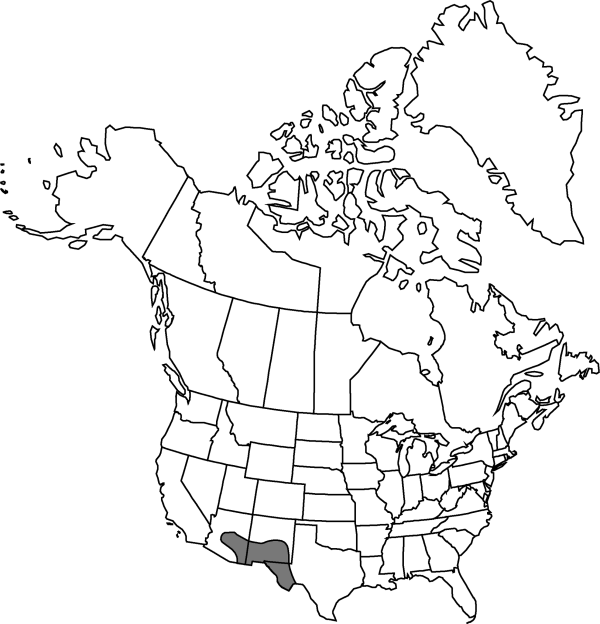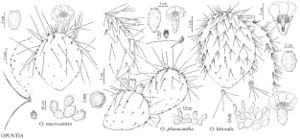Difference between revisions of "Opuntia macrocentra"
Proc. Amer. Acad. Arts 3: 292. 1856.
FNA>Volume Importer |
imported>Volume Importer |
||
| (7 intermediate revisions by 2 users not shown) | |||
| Line 8: | Line 8: | ||
}} | }} | ||
|common_names=Black-spined pricklypear;purple pricklypear | |common_names=Black-spined pricklypear;purple pricklypear | ||
| + | |special_status={{Treatment/ID/Special_status | ||
| + | |code=F | ||
| + | |label=Illustrated | ||
| + | }} | ||
|basionyms= | |basionyms= | ||
|synonyms={{Treatment/ID/Synonym | |synonyms={{Treatment/ID/Synonym | ||
|name=Opuntia violacea | |name=Opuntia violacea | ||
|authority=Engelmann ex B. D. Jackson | |authority=Engelmann ex B. D. Jackson | ||
| − | }}{{Treatment/ID/Synonym | + | |rank=species |
| + | }} {{Treatment/ID/Synonym | ||
|name=Opuntia violacea var. castetteri | |name=Opuntia violacea var. castetteri | ||
|authority=L. D. Benson | |authority=L. D. Benson | ||
| − | }}{{Treatment/ID/Synonym | + | |rank=variety |
| + | }} {{Treatment/ID/Synonym | ||
|name=Opuntia violacea var. macrocentra | |name=Opuntia violacea var. macrocentra | ||
|authority=(Engelmann) L. D. Benson | |authority=(Engelmann) L. D. Benson | ||
| + | |rank=variety | ||
}} | }} | ||
|hierarchy=Cactaceae;Cactaceae subfam. Opuntioideae;Opuntia;Opuntia macrocentra | |hierarchy=Cactaceae;Cactaceae subfam. Opuntioideae;Opuntia;Opuntia macrocentra | ||
| Line 26: | Line 33: | ||
}}<!-- | }}<!-- | ||
| − | --><span class="statement" id="st- | + | --><span class="statement" id="st-undefined" data-properties=""><b>Shrubs,</b> erect to decumbent, to 1 m. <b>Stem</b> segments not easily detached, purple (particularly under stress) to green with purple near areoles and margins of stem segment, flattened, broadly obovate to subcircular, thickish, 7–20 × 6–18 cm; areoles 6–8(–10) per diagonal row across midstem segment, elliptic to circular, 3–7 × 2.5–5 mm; wool tan to whitish, aging black. <b>Spines</b> 0 or 1–15+ per areole, few and at distal areoles or many and on most areoles, usually erect to spreading, appearing unruly, sometimes deflexed, straight or curving, acicular, often flexible, subterete to flattened basally; longer ones reddish brown to ± black (rarely yellow to red in w Texas), or partly to wholly white, 30–120(–170) mm; reflexed spine rarely present, 1 in some areoles, short, whitish. <b>Glochids</b> dense in crescent at adaxial edge of areole and well-developed subapical tuft, reddish yellow, aging brown, 2–3(–6) mm. <b>Flowers</b>: inner tepals yellow with red basal portions, obovate-apiculate, 25–40 mm; filaments and anthers yellowish; style cream; stigma lobes green. <b>Fruits</b> red to purplish, obovoid to barrel-shaped, 25–40 × 20–23 mm, fleshy or ± juicy, glabrous, spineless; umbilicus 8–10 mm deep; areoles 22–44. <b>Seeds</b> yellowish, suborbicular to reniform, angled, 5–7 × 3.5–5 mm, sides flattened; girdle protruding 0.8–1.2 mm. <b>2n</b> = 22, 44.</span><!-- |
-->{{Treatment/Body | -->{{Treatment/Body | ||
| + | |phenology=Flowering spring (Mar–Jun). | ||
|habitat=Desert uplands, grasslands, oak woodlands, sandy desert flats, rocky hills and valleys | |habitat=Desert uplands, grasslands, oak woodlands, sandy desert flats, rocky hills and valleys | ||
|elevation=900-1600 m | |elevation=900-1600 m | ||
|distribution=Ariz.;N.Mex.;Tex.;Mexico (Chihuahua;Coahuila;Sonora). | |distribution=Ariz.;N.Mex.;Tex.;Mexico (Chihuahua;Coahuila;Sonora). | ||
| − | |discussion=<p>Opuntia macrocentra var. minor is represented by relatively short and compact shrubs with a glochid pattern of a dense crescent in the adaxial edge of the areoles like the species and a much taller tuft of spreading glochids. This variety, which grows along the western side of the Rio Grande in Big Bend, Texas, appears best interpreted as a tetraploid hybrid between tetraploid putative parents, Opuntia macrocentra and O. tortispina.</p> | + | |discussion=<p><i>Opuntia macrocentra</i> <i></i>var.<i> minor</i> is represented by relatively short and compact shrubs with a glochid pattern of a dense crescent in the adaxial edge of the areoles like the species and a much taller tuft of spreading glochids. This variety, which grows along the western side of the Rio Grande in Big Bend, Texas, appears best interpreted as a tetraploid hybrid between tetraploid putative parents, <i>Opuntia macrocentra</i> and <i>O. tortispina</i>.</p> |
|tables= | |tables= | ||
|references= | |references= | ||
| Line 41: | Line 49: | ||
-->{{#Taxon: | -->{{#Taxon: | ||
name=Opuntia macrocentra | name=Opuntia macrocentra | ||
| − | |||
|authority=Engelmann | |authority=Engelmann | ||
|rank=species | |rank=species | ||
| Line 48: | Line 55: | ||
|basionyms= | |basionyms= | ||
|family=Cactaceae | |family=Cactaceae | ||
| + | |phenology=Flowering spring (Mar–Jun). | ||
|habitat=Desert uplands, grasslands, oak woodlands, sandy desert flats, rocky hills and valleys | |habitat=Desert uplands, grasslands, oak woodlands, sandy desert flats, rocky hills and valleys | ||
|elevation=900-1600 m | |elevation=900-1600 m | ||
| Line 54: | Line 62: | ||
|publication title=Proc. Amer. Acad. Arts | |publication title=Proc. Amer. Acad. Arts | ||
|publication year=1856 | |publication year=1856 | ||
| − | |special status= | + | |special status=Illustrated |
| − | |source xml=https:// | + | |source xml=https://bitbucket.org/aafc-mbb/fna-data-curation/src/2e0870ddd59836b60bcf96646a41e87ea5a5943a/coarse_grained_fna_xml/V4/V4_261.xml |
|subfamily=Cactaceae subfam. Opuntioideae | |subfamily=Cactaceae subfam. Opuntioideae | ||
|genus=Opuntia | |genus=Opuntia | ||
|species=Opuntia macrocentra | |species=Opuntia macrocentra | ||
| − | |||
| − | |||
| − | |||
| − | |||
| − | |||
| − | |||
| − | |||
| − | |||
| − | |||
| − | |||
| − | |||
| − | |||
| − | |||
| − | |||
| − | |||
| − | |||
| − | |||
| − | |||
| − | |||
| − | |||
| − | |||
| − | |||
| − | |||
| − | |||
| − | |||
| − | |||
| − | |||
| − | |||
| − | |||
| − | |||
| − | |||
| − | |||
| − | |||
| − | |||
| − | |||
| − | |||
| − | |||
| − | |||
| − | |||
| − | |||
| − | |||
| − | |||
| − | |||
| − | |||
| − | |||
| − | |||
| − | |||
| − | |||
| − | |||
| − | |||
| − | |||
| − | |||
| − | |||
| − | |||
| − | |||
| − | |||
| − | |||
| − | |||
}}<!-- | }}<!-- | ||
-->[[Category:Treatment]][[Category:Opuntia]] | -->[[Category:Treatment]][[Category:Opuntia]] | ||
Latest revision as of 21:57, 5 November 2020
Shrubs, erect to decumbent, to 1 m. Stem segments not easily detached, purple (particularly under stress) to green with purple near areoles and margins of stem segment, flattened, broadly obovate to subcircular, thickish, 7–20 × 6–18 cm; areoles 6–8(–10) per diagonal row across midstem segment, elliptic to circular, 3–7 × 2.5–5 mm; wool tan to whitish, aging black. Spines 0 or 1–15+ per areole, few and at distal areoles or many and on most areoles, usually erect to spreading, appearing unruly, sometimes deflexed, straight or curving, acicular, often flexible, subterete to flattened basally; longer ones reddish brown to ± black (rarely yellow to red in w Texas), or partly to wholly white, 30–120(–170) mm; reflexed spine rarely present, 1 in some areoles, short, whitish. Glochids dense in crescent at adaxial edge of areole and well-developed subapical tuft, reddish yellow, aging brown, 2–3(–6) mm. Flowers: inner tepals yellow with red basal portions, obovate-apiculate, 25–40 mm; filaments and anthers yellowish; style cream; stigma lobes green. Fruits red to purplish, obovoid to barrel-shaped, 25–40 × 20–23 mm, fleshy or ± juicy, glabrous, spineless; umbilicus 8–10 mm deep; areoles 22–44. Seeds yellowish, suborbicular to reniform, angled, 5–7 × 3.5–5 mm, sides flattened; girdle protruding 0.8–1.2 mm. 2n = 22, 44.
Phenology: Flowering spring (Mar–Jun).
Habitat: Desert uplands, grasslands, oak woodlands, sandy desert flats, rocky hills and valleys
Elevation: 900-1600 m
Distribution

Ariz., N.Mex., Tex., Mexico (Chihuahua, Coahuila, Sonora).
Discussion
Opuntia macrocentra var. minor is represented by relatively short and compact shrubs with a glochid pattern of a dense crescent in the adaxial edge of the areoles like the species and a much taller tuft of spreading glochids. This variety, which grows along the western side of the Rio Grande in Big Bend, Texas, appears best interpreted as a tetraploid hybrid between tetraploid putative parents, Opuntia macrocentra and O. tortispina.
Selected References
None.
